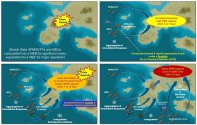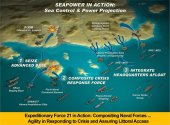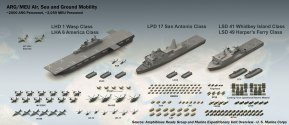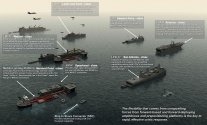Type 071 for Thai Navy costs 200 million. Can't see why Type 075 should cost at least 4 times moreFor Taiwan, it's almost certainly more cost effective to buy the [Type-072A LST] over the [Type-075 LHD]
I reckon a Type-075 is easily $800+ Million
And a Type-072A is about $14 Million, based on the comparable cost of the Teluk Bintuni LST.
So 20 Type-072A would only cost one-third of a single Type-0975, but would have roughly twice the cargo capacity.
You are using an out of date browser. It may not display this or other websites correctly.
You should upgrade or use an alternative browser.
You should upgrade or use an alternative browser.
075 LHD thread
- Thread starter nosh
- Start date
antiterror13
Brigadier
Just curious here, but does anyone have any idea on why the construction of 075 LHDs are stopped at just mere 3 ships?
It is said (according to Wikipedia and some Chinese sources) that the next batch would have 5 ships in total, which brings to the total planned number of 8 ships for the 075-class. However, there has been zero indication on the contruction of the remainder 5 members of the 075-class ever being initiated.
This is in line with the Taiwan question being brought closer to criticality as time passes by - Shouldn't PLAN be more concerned with acquiring more 075s at faster pace in order to meet the demand for a future hypothetical war across the strait?
Or is it that the PLAN would prefer to transfer the orders for the remainder 5 members of the 075-class to the succeeding 076 LHDs, like how the PLAN cancelled the last few 054A FFGs and allocated their initial orders to newer 054B FFGs?
Wait wait ..... , where did you hear that "PLAN cancelled the last few 054A FFGs and allocated their initial orders to newer 054B FFG" ?
Thats interesting development
Losing whole ships full of hard-trained marines kinda hurts.A Phalanx CIWS is coming in at $15 Million these days.
That would be more than the estimated cost of an entire Type-072A.
So is it actually worth installing CIWS systems? You could buy more LSTs and Escort Frigates to compensate
Certainly more than the cost of installing a basic self-defense apparatus.
I heard 8 of the 20 054As got cancelled. No idea about 054B thoughWait wait ..... , where did you hear that "PLAN cancelled the last few 054A FFGs and allocated their initial orders to newer 054B FFG" ?
Thats interesting development
You will never have enough 054A/Bs for other missions, while 072As with a reliable CIWS would give you more freedom tactically. For example, they could work as mobile platforms for army artillery forces, esp. MRLS units.True.
But we've established that using Type-054A frigates is a more efficient and effective means of air defence than more CIWS on ships, as a general rule.
But now consider that there are hundreds of transport ships comprising:
1. large amphibious ships (where CIWS makes sense)
2. smaller amphibious ships
3. many unarmed civilian cargo ships
Such a fleet would justify enough Type-054A Frigates to cover the entire route from Taiwan to Mainland China.
So I'm using the Type-054A as an example, but you could analyse with the Type-052D instead, which is roughly twice the cost of a Type-054A. You get a better radar to detect and track incoming missiles and the option of longer range SAMs. When the quad-pack SAM is ready - many more SAMs will be available and the cost per SAM launched should be cheaper than the Type-054A.
Losing whole ships full of hard-trained marines kinda hurts.
True. But improving air defences for amphibious ships is better served with even more medium-range SAM systems on frigates or destroyers.
Certainly more than the cost of installing a basic self-defense apparatus.
The problem is that a CIWS is not a basic self defence system for a LST. You could be looking at doubling the cost, based on the previous numbers.
In comparison, a larger Type-071 LPD might cost $200 million, so a $15 million CIWS looks like a reasonable system to add.
As for the 071, I want it to be improved in terms of CIWS too. Four AK-630s ain’t effective enough to me…True. But improving air defences for amphibious ships is better served with even more medium-range SAM systems on frigates or destroyers.
The problem is that a CIWS is not a basic self defence system for a LST. You could be looking at doubling the cost, based on the previous numbers.
In comparison, a larger Type-071 LPD might cost $200 million, so a $15 million CIWS looks like a reasonable system to add.
Not the same thing... the problem is leakers - and there almost inevitably will be leakers.True. But improving air defences for amphibious ships is better served with even more medium-range SAM systems on frigates or destroyers.
Final defense better to be left to the ship itself - not only for the line of sight reasons(when attacking missiles enter into close formation - it's everyone for themselves time), but also for simple moral reasons.
Furthermore, in the end landing ships will have to expose themselves - near the invasion beachhead(s) at very least.
Outer layer is not a replacement for their own one - especially for escorted ships (i.e. those which really are objects in air-sea battle).
My reply is general, quote below is only for context:
This kind of speculation should be grounded in proper study of amphibious warfare:
The purpose of a landing is to establish a secure logistical base for sustaining operations in hostile territory. All other purposes are secondary and the previous USMC doctrine (Expeditionary Force 21) involves staging of combat operations at sea and at large distances from enemy territory until a logistical base is established, ideally by capturing an existing port facility.
An opposed landing occurs when deployment of forces in hostile territory is actively contested by enemy forces. The kind of deployment or enemy response is irrelevant. While unopposed landings are preferable most landings today would be opposed landings because how technology affects space and time constraints. In WW2 many landings were unopposed for that reason.
Beach assault is a specific term for capturing a defended beach which indicates that no other point of entry and no staging ground on the shore are available. It is the worst tactical scenario and is to be avoided at all cost. Most of post-WW2 doctrinal development - including the LHD concept - stems from the need to avoid beach assaults.
The primary role of a amphibious ships is to transport force from point of departure to the landing zone. Combat deployment is only the secondary purpose. LSTs were invented due to lack of infrastructure.
Expeditionary Force 21 concept illustrates it very well:

Amphibious operations are all about establishing logistical networks. Once those are established "amphibious" becomes ordinary sea transit. There is no need for large amphibious force if shore-to-shore logistics is secured. The side with overall advantage (air and naval esp.) can take its time.

Note two things:

Sea-basing demonstrates how civilian assets can be integrated into the operation - just imagine existing and extensive infrastructure as well as civilian engineering/logistical vessels being employed:

Considering the geography and the scale of sea construction that occurs in Asia, which is not present in North America, I fail to see the need for dedicated military vessels.
The reason why I show these graphics is because in my view Expeditionary Force 21 represents the pinnacle of amphibious doctrine, the USMC is the most experienced amphibious formation in modern history and therefore logically PLA will use USMC amphibious doctrine to inform its own and the development PLAN amphibious assets. It is "best practice" so while graphics show USN assets we should imagine them as PLAN ships of equivalent capability to better understand the problem.
As for Taiwan the best analogy is landing in Sicily.
I also prepared my own interpretation of "most efficient" operation in Taiwan:
If you compare the locations and distances and keep in mind range limitation of helicopters as well as capability of modern artillery targeting logistics (see Ukraine for reference) then having a mobile airfield in support of traditional land-based staging of amphibious operations in advance positions (smaller islands around Taiwan) is critical. Sea transit is exceedingly vulnerable and amphibious operations are much more complex logistically and time-consuming than most people imagine them to be. More land-hops won't slow down the operation and will greatly increase the survivability and tactical options. The more land-hops are available the less need for LSTs and more options for LCAC, civilian assets and air transport.
Consequently I can't imagine that PLAN would cease procurement of LHDs or choose a larger proportion of LPDs or LSTs which can be much more easily replaced by non-military assets. LHD is the only asset that can successfully scale battle into multiple domains because of its size and the size of air deck.
If the three-fleet (N,E & S) structure is to be maintained I would expect a minimum of 9 LHDs total (3 per fleet) and an optimal number of 12 LHDs (2 pairs per fleet) although NSF might not operate LHDs and instead SSF will have double numbers. For now the three 075s are test units. Whether more 075 follow or there's a change to another design will come from those tests. I also think that crews are of more importance than vessels so if the "training crews" are ready then production of LHDs will commence.
I find the above to be only logical and so my personal expectations of future PLAN procurement in amphibious domain follow the above conclusions.
The advantage of type 075, besides it size, is the flexibility of deploying troops on shore. It has helicopters and LCAC for high speed assault on the beach front as well as insertion of troops further inland from the beach front, and it can do commando raids as well. The speed of helicopters and LCAC also means that if the original planned landing site is too hot, they can quickly move to alternate landing site with little time loss. This is where type 072 is not capable of.
Financial cost is not an important consideration in initial phase of beach assault, human cost has priority. After establishing a safe beach front when transportaion of materials and reinforcement will be carried out in earnest, then cheap transpor ships (i.e. low financial costs) will play their roles.
In short, type 075 and type 072 have their own role to play, and they should not exclude each other.
This kind of speculation should be grounded in proper study of amphibious warfare:
The purpose of a landing is to establish a secure logistical base for sustaining operations in hostile territory. All other purposes are secondary and the previous USMC doctrine (Expeditionary Force 21) involves staging of combat operations at sea and at large distances from enemy territory until a logistical base is established, ideally by capturing an existing port facility.
An opposed landing occurs when deployment of forces in hostile territory is actively contested by enemy forces. The kind of deployment or enemy response is irrelevant. While unopposed landings are preferable most landings today would be opposed landings because how technology affects space and time constraints. In WW2 many landings were unopposed for that reason.
Beach assault is a specific term for capturing a defended beach which indicates that no other point of entry and no staging ground on the shore are available. It is the worst tactical scenario and is to be avoided at all cost. Most of post-WW2 doctrinal development - including the LHD concept - stems from the need to avoid beach assaults.
The primary role of a amphibious ships is to transport force from point of departure to the landing zone. Combat deployment is only the secondary purpose. LSTs were invented due to lack of infrastructure.
Expeditionary Force 21 concept illustrates it very well:

Amphibious operations are all about establishing logistical networks. Once those are established "amphibious" becomes ordinary sea transit. There is no need for large amphibious force if shore-to-shore logistics is secured. The side with overall advantage (air and naval esp.) can take its time.

Note two things:
- "seize advanced base' is the first step in all operations per doctrine.
- the largest autonomous force is the Amphibious Ready Group carrying a Marine Expeditionary Unit (MEU) a battalion-sized tactical formation deploying company-sized assault/landing teams and everything else is multiples of MEU (MEB/MEF) and utilizes sea-basing.

Sea-basing demonstrates how civilian assets can be integrated into the operation - just imagine existing and extensive infrastructure as well as civilian engineering/logistical vessels being employed:

Considering the geography and the scale of sea construction that occurs in Asia, which is not present in North America, I fail to see the need for dedicated military vessels.
The reason why I show these graphics is because in my view Expeditionary Force 21 represents the pinnacle of amphibious doctrine, the USMC is the most experienced amphibious formation in modern history and therefore logically PLA will use USMC amphibious doctrine to inform its own and the development PLAN amphibious assets. It is "best practice" so while graphics show USN assets we should imagine them as PLAN ships of equivalent capability to better understand the problem.
As for Taiwan the best analogy is landing in Sicily.
I also prepared my own interpretation of "most efficient" operation in Taiwan:
PLA Strategy in a Taiwan Contingency
Singapore is not in a position to disallow anything. If there's a conflict between China and the US and a country where the US is based tries to prevent the use of its facilities, the US will attack it. In Singapore's case I doubt things have to go that far since they operate F-35s, the US could...
www.sinodefenceforum.com
If you compare the locations and distances and keep in mind range limitation of helicopters as well as capability of modern artillery targeting logistics (see Ukraine for reference) then having a mobile airfield in support of traditional land-based staging of amphibious operations in advance positions (smaller islands around Taiwan) is critical. Sea transit is exceedingly vulnerable and amphibious operations are much more complex logistically and time-consuming than most people imagine them to be. More land-hops won't slow down the operation and will greatly increase the survivability and tactical options. The more land-hops are available the less need for LSTs and more options for LCAC, civilian assets and air transport.
Consequently I can't imagine that PLAN would cease procurement of LHDs or choose a larger proportion of LPDs or LSTs which can be much more easily replaced by non-military assets. LHD is the only asset that can successfully scale battle into multiple domains because of its size and the size of air deck.
If the three-fleet (N,E & S) structure is to be maintained I would expect a minimum of 9 LHDs total (3 per fleet) and an optimal number of 12 LHDs (2 pairs per fleet) although NSF might not operate LHDs and instead SSF will have double numbers. For now the three 075s are test units. Whether more 075 follow or there's a change to another design will come from those tests. I also think that crews are of more importance than vessels so if the "training crews" are ready then production of LHDs will commence.
I find the above to be only logical and so my personal expectations of future PLAN procurement in amphibious domain follow the above conclusions.
Not the same thing... the problem is leakers - and there almost inevitably will be leakers.
Final defense better to be left to the ship itself - not only for the line of sight reasons(when attacking missiles enter into close formation - it's everyone for themselves time), but also for simple moral reasons.
But if you add more medium range SAMs (which are more effective for the cost than CIWS) - you get fewer or no leakers.
So overall, it is more effective to keep adding medium range SAMs until you get blanket coverage.
Furthermore, in the end landing ships will have to expose themselves - near the invasion beachhead(s) at very least.
Next to a beach, what is better?
Option 1. LSTs, each with a CIWS
Option 2. Twice the number of LSTs without CIWS
And I would expect at least 6 destroyers and frigates with hundreds of SAMs available for cover.
Outer layer is not a replacement for their own one - especially for escorted ships (i.e. those which really are objects in air-sea battle).
Think about it. The civilian Ro-Ro ships can carry a few hundred vehicles at a time, yet they are defenceless. There is no alternative but solid medium-range and long-range air defence. Given that is the case, then unarmed LSTs can piggyback off this and dispense with CIWS.
